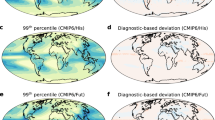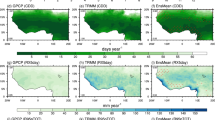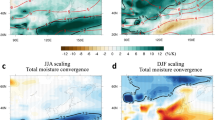Abstract
Future changes in rainfall have serious impacts on human adaptation to climate change, but quantification of these changes is subject to large uncertainties in climate model projections. To narrow these uncertainties, significant efforts have been made to understand the intermodel differences in future rainfall changes. Here, we show a strong inverse relationship between present-day precipitation and its future change to possibly calibrate future precipitation change by removing the present-day bias in climate models. The results of the models with less tropical (40° S–40° N) present-day precipitation are closely linked to the dryness over the equatorial central-eastern Pacific, and project weaker regional precipitation increase due to the anthropogenic greenhouse forcing1,2,3,4,5,6 with stronger zonal Walker circulation. This induces Indo-western Pacific warming through Bjerknes feedback, which reduces relative humidity by the enhanced atmospheric boundary-layer mixing in the future projection. This increases the air–sea humidity difference to enhance tropical evaporation and the resultant precipitation. Our estimation of the sensitivity of the tropical precipitation per 1 K warming, after removing a common bias in the present-day simulation, is about 50% greater than the original future multi-model projection.
This is a preview of subscription content, access via your institution
Access options
Access Nature and 54 other Nature Portfolio journals
Get Nature+, our best-value online-access subscription
$29.99 / 30 days
cancel any time
Subscribe to this journal
Receive 12 print issues and online access
$209.00 per year
only $17.42 per issue
Buy this article
- Purchase on Springer Link
- Instant access to full article PDF
Prices may be subject to local taxes which are calculated during checkout




Similar content being viewed by others
References
Neelin, J. D., Münnich, M., Su, H., Meyerson, J. E. & Holloway, C. E. Tropical drying trends in global warming models and observations. Proc. Natl Acad. Sci. USA 103, 6110–6115 (2006).
Liu, C. & Allan, R. P. Observed and simulated precipitation responses in wet and dry regions 1850–2100. Environ. Res. Lett. 8, 034002 (2013).
Held, I. M. & Soden, B. J. Robust responses of the hydrological cycle to global warming. J. Clim. 19, 5686–5699 (2006).
Mitchell, J. F., Wilson, C. A. & Cunnington, W. M. On CO2 climate sensitivity and model dependence of results. Q. J. Royal Meteorol. Soc. 113, 293–322 (1987).
Chou, C. et al. Increase in the range between wet and dry season precipitation. Nat. Geosci. 6, 263–267 (2013).
Huang, P., Xie, S. P., Hu, K., Huang, G. & Huang, R. Patterns of the seasonal response of tropical rainfall to global warming. Nat. Geosci. 6, 357–361 (2013).
Soden, B. J. & Held, I. M. An assessment of climate feedbacks in coupled ocean-atmosphere models. J. Clim. 19, 3354–3360 (2006).
Webb, M. J. et al. On the contribution of local feedback mechanisms to the range of climate sensitivity in two GCM ensembles. Clim. Dyn. 27, 17–38 (2006).
Gettelman, A., Kay, J. E. & Shell, K. M. The evolution of climate sensitivity and climate feedbacks in the community atmosphere model. J. Clim. 25, 1453–1469 (2012).
Sherwood, S. C., Bony, S. & Dufresne, J. L. Spread in model climate sensitivity traced to atmospheric convective mixing. Nature 505, 37–42 (2014).
Collins, M. et al. Quantifying future climate change. Nat. Clim. Change 2, 403–409 (2012).
Huang, P. & Ying, J. A multimodel ensemble pattern regression method to correct the tropical Pacific SST change patterns under global warming. J. Clim. 28, 4706–4723 (2015).
Ham, Y. G. & Kug, J.-S. Present-day constraint for tropical Pacific precipitation changes due to global warming in CMIP5 models. Asia-Pacific J. Atmos. Sci. 52, 459–466 (2016).
Lu, J. & Cai, M. Stabilization of the atmospheric boundary layer and the muted global hydrological cycle response to global warming. J. Hydrometeorol. 10, 347–352 (2009).
Richter, I. & Xie, S. P. Muted precipitation increase in global warming simulations: A surface evaporation perspective. J. Geophys. Res. 113, D24118 (2008).
Trenberth, K. E. Changes in precipitation with climate change. Clim. Res. 47, 123–138 (2011).
Westra, S., Alexander, L. V. & Zwiers, F. W. Global increasing trends in annual maximum daily precipitation. J. Clim. 26, 3904–3918 (2013).
Jin, F. F. An equatorial ocean recharge paradigm for ENSO. Part I: Conceptual model. J. Atmos. Sci. 54, 811–829 (1997).
Kug, J. S., Kang, I. S. & Jhun, J. G. Western Pacific SST prediction with an intermediate El Niño prediction model. Mon. Weather Rev. 133, 1343–1352 (2005).
Ham, Y. G. & Kug, J. S. How well do current climate models simulate two types of El Nino? Clim. Dyn. 39, 383–398 (2012).
Watanabe, M., Chikira, M., Imada, Y. & Kimoto, M. Convective control of ENSO simulated in MIROC. J. Clim. 24, 543–562 (2011).
Hurrell, J. et al. The Community Earth System Model: A framework for collaborative research. Bull. Am. Meteor. Soc. 94, 1339–1360 (2013).
Hayes, S. P., McPhaden, M. J. & Wallace, J. M. The influence of sea-surface temperature on surface wind in the eastern equatorial Pacific: Weekly to monthly variability. J. Clim. 2, 1500–1506 (1989).
Wallace, J. M., Mitchell, T. P. & Deser, C. The influence of sea-surface temperature on surface wind in the eastern equatorial Pacific: Seasonal and interannual variability. J. Clim. 2, 1492–1499 (1989).
Samelson, R. M. et al. On the coupling of wind stress and sea surface temperature. J. Clim. 19, 1557–1566 (2006).
Collins, M. El Niño- or La Niña-like climate change? Clim. Dyn. 24, 89–104 (2005).
An, S. I., Kug, J. S., Ham, Y. G. & Kang, I. S. Successive modulation of ENSO to the future greenhouse warming. J. Clim. 21, 3–21 (2008).
Liu, J. et al. What drives the global summer monsoon over the past millennium? Clim. Dyn. 39, 1063–1072 (2012).
Liu, J., Wang, B., Cane, M. A., Yim, S. Y. & Lee, J. Y. Divergent global precipitation changes induced by natural versus anthropogenic forcing. Nature 493, 656–659 (2013).
Allen, M. R. & Ingram, W. J. Constraints on future changes in climate and the hydrological cycle. Nature 419, 224–232 (2002).
Ham, Y. G. & Kug, J. S. Improvement of ENSO simulation based on intermodel diversity. J. Clim. 28, 998–1015 (2015).
Adler, R. F. et al. The version-2 global precipitation climatology project (GPCP) monthly precipitation analysis (1979-present). J. Hydrometeorol. 4, 1147–1167 (2003).
Xie, P. & Arkin, P. A. Global precipitation: A 17-year monthly analysis based on gauge observations, satellite estimates, and numerical model outputs. Bull. Am. Meteor. Soc. 78, 2539–2558 (1997).
Rienecker, M. M. et al. MERRA - NASA’s modern-era retrospective analysis for research and applications. J. Clim. 24, 3624–3648 (2011).
Dee, D. P. et al. The ERA-Interim reanalysis: configuration and performance of the data assimilation system. Q. J. Royal Meteorol. Soc. 137, 553–597 (2011).
Marsh, K. N. (ed.) Recommended Reference Materials for the Realization of Physicochemical Properties (Blackwell, Oxford, 1987).
Smith, T. M., Reynolds, R. W., Peterson, T. C., & Lawrimore, J. Improvements to NOAA’s historical merged land–ocean surface temperature analysis (1880–2006). J. Climate 21, 2283–2296 (2008).
Acknowledgements
Y.-G.H. was supported by the Basic Science Research Program through the National Research Foundation of Korea (NRF) funded by the Ministry of Education (NRF-2016R1A6A1A03012647). J.-Y.C. was supported by the Korean Meteorological Administration Research and Development Program under grant KMIPA2015–6170. J.-S.K. is supported by the National Research Foundation of Korea (NRF-2017R1A2B3011511).
Author information
Authors and Affiliations
Contributions
Y.-G.H. and J.-S.K. designed the research, conducted analyses and wrote the majority of the manuscript. M.W. and F.-F.J. conducted the analysis and report-writing tasks. J.-Y.C. performed the model experiments. All of the authors discussed the study results and reviewed the manuscript.
Corresponding author
Ethics declarations
Competing interests
The authors declare no competing financial interests.
Additional information
Publisher’s note: Springer Nature remains neutral with regard to jurisdictional claims in published maps and institutional affiliations.
Supplementary information
Supplementary Information
Supplementary Table 1 and Supplementary Figures 1–15.
Rights and permissions
About this article
Cite this article
Ham, YG., Kug, JS., Choi, JY. et al. Inverse relationship between present-day tropical precipitation and its sensitivity to greenhouse warming. Nature Clim Change 8, 64–69 (2018). https://doi.org/10.1038/s41558-017-0033-5
Received:
Accepted:
Published:
Issue Date:
DOI: https://doi.org/10.1038/s41558-017-0033-5
This article is cited by
-
Intermodel relation between present-day warm pool intensity and future precipitation changes
Climate Dynamics (2024)
-
Enhanced joint impact of western hemispheric precursors increases extreme El Niño frequency under greenhouse warming
Nature Communications (2023)
-
Present-day warm pool constrains future tropical precipitation
Communications Earth & Environment (2022)
-
A bias-corrected projection for the changes in East Asian summer monsoon rainfall under global warming
Climate Dynamics (2020)
-
Low clouds link equilibrium climate sensitivity to hydrological sensitivity
Nature Climate Change (2018)



